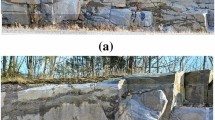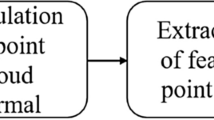Abstract
The detection of planar regions from three-dimensional (3-D) laser scanning point clouds has become more and more significant in many scientific fields, including 3-D reconstruction, augmented reality and analysis of discontinuities. In rock engineering, planes extracted from rock mass point clouds are the foundational step to build 3-D numerical models of rock mass, which is significant in analysis of rock stability. In the past, several approaches have been proposed for detecting planes from TLS point clouds. However, these methods have difficulties in processing rock points because of the uniqueness of rock. This paper introduces a novel and efficient method for plane detection from 3-D rock mass point clouds. Firstly, after filtering the raw point clouds of rock mass acquired through laser scanning, the point cloud is split into some small voxels according to the specified resolution. Then, for the purpose of acquisition of high-quality growth units, an accurate coplanarity test process is used in each voxel. Meanwhile, the accurate neighborhood information can be built according to the result of coplanarity test. Finally, small voxels are clustered into a completed plane by region growing and the procedure of postprecessing. The performance of this method was tested in one icosahedron point cloud and three rock mass point clouds. Compared with the existing methods, the results demonstrate superior performance of our method in the field of plane detection.














Similar content being viewed by others
References
Abellán A, Oppikofer T, Jaboyedoff M, Rosser NJ, Lim M, Lato M (2014) Terrestrial laser scanning of rock slope instabilities. Earth Surf Process Landf 39(1):80–97
Awwad TM, Zhu Q, Du Z, Zhang Y (2010) An improved segmentation approach for planar surfaces from unstructured 3d point clouds. Photogramm Rec 25 (129):5–23
Borrmann D, Elseberg J, Kai L, NÍźchter A (2011) The 3d hough transform for plane detection in point clouds: A review and a new accumulator design. 3d Res 2(2):1–13
Bretar F, Roux M (2005) Extraction of 3d planar primitives from raw airborne laser data: a normal driven ransac approach. In: Iapr conference on machine vision applications, pp 452–455
Deschaud J-E, Goulette F (2010) cOis a fast and accurate plane detection algorithm for large noisy point clouds using filtered normals and voxel growing. In: Proceedings of 3D Processing, Visualization and Transmission Conference
Duda RO, Hart PE (1972) Use of the hough transformation to detect lines and curves in pictures. Commun ACM 15(1):11–15
Fan D-P, Cheng M-M, Liu Y, Li T, Borji A (2017) Structure-measure: A new way to evaluate foreground maps. In: Proceedings of the IEEE international conference on computer vision, pp 4548–4557
Fan D-P, Gong C, Cao Y, Bo R, Cheng M-M, Borji A (2018) Enhanced-alignment measure for binary foreground map evaluation. In: International joint conferences on artificial intelligence
Fernandes LAF, Oliveira MM (2008) Real-time line detection through an improved hough transform voting scheme. Pattern Recogn 41(1):299–314
Ferrero A, Forlani G, Roncella R, Voyat HI (2009) Advanced geostructural survey methods applied to rock mass characterization. Rock Mech Rock Eng 42 (4):631–665
Fischler MA, Bolles RC (1981) Random sample consensus: a paradigm for model fitting with applications to image analysis and automated cartography. Commun ACM 24(6):381–395
Forlani G, Nardinocchi C, Scaioni M (2006) Complete classification of raw lidar data and 3d reconstruction of buildings. Pattern Anal Applic 8(4):357–374
Gigli G, Mugnai F, Leoni L, Casagli N (2009) Brief communication ”analysis of deformations in historic urban areas using terrestrial laser scanning. Nat Hazards Earth Syst Sci 9(6):1759–1761
Gigli G, Casagli N (2011) Semi-automatic extraction of rock mass structural data from high resolution lidar point clouds. Int J Rock Mech Min Sci 48(2):187–198
Gomes RK, De Oliveira LPL, Luiz G Jr, Tognoli FMW, Veronez MR, De Souza MK (2016) An algorithm for automatic detection and orientation estimation of planar structures in lidar-scanned outcrops. Comput Geosci 90:170–178
Hähnel D, Burgard W, Thrun S (2003) Learning compact 3d models of indoor and outdoor environments with a mobile robot. Robot Auton Syst 44(1):15–27
He L, An XM, Ma GW, Zhao ZY (2013) Development of three-dimensional numerical manifold method for jointed rock slope stability analysis. Int J Rock Mech Min Sci 64(6):22–35
Holz D, Behnke S (2012) Fast range image segmentation and smoothing using approximate surface reconstruction and region growing. In: International conference on intelligent autonomous systems, pp 61–73
Hu Z, Bai D (2017) Planar object detection from 3d point clouds based on pyramid voxel representation. Multimed Tools Appl 76(22):24343–24357
Hu L, Xiao J, Wang Y (2019) An automatic 3d registration method for rock mass point clouds based on plane detection and polygon matching. Vis Comput:1–13. https://doi.org/10.1007/s00371-019-01648-z
Lato M, Vöge M (2012) Automated mapping of rock discontinuities in 3d lidar and photogrammetry models. Int J Rock Mech Min Sci 54(3):150–158
Lato M, Kemeny J, Harrap RM, Bevan G (2013) Rock bench: Establishing a common repository and standards for assessing rockmass characteristics using lidar and photogrammetry. Comput Geosci 50(1):106–114
Leng X, Xiao J, Wang Y (2016) A multi-scale plane-detection method based on the hough transform and region growing. Photogramm Rec 31(154):166–192
Limberger FA, Oliveira MM (2015) Real-time detection of planar regions in unorganized point clouds. Pattern Recogn 48(6):2043–2053
Lin H, Gao Ju, Yu Z, Lu G, Ye M, Zhang C, Liu L, Yang R (2013) Semantic decomposition and reconstruction of residential scenes from lidar data. Acm Trans Graph 32(4):66:1–66:10
Liu J, Wu ZK (2014) An adaptive approach for primitive shape extraction from point clouds. Optik - Int J Light Electron Opt 125(9):2000–2008
Margolin R, Zelnik-Manor L, Tal A (2014) How to evaluate foreground maps?. In: Proceedings of the IEEE conference on computer vision and pattern recognition, pp 248–255
Nie G-Y, Cheng M-M, Liu Y, Liang Z, Fan D-P, Liu Y, Wang Y (2019) Multi-level context ultra-aggregation for stereo matching. In: Proceedings of the IEEE Conference on Computer Vision and Pattern Recognition, pp 3283–3291
Oesau S, Lafarge F, Alliez P (2015) Planar shape detection and regularization in tandem. Comput Graph Forum 35(17):2453–4
Poppinga J, Vaskevicius N, Birk A, Pathak K (2008) Fast plane detection and polygonalization in noisy 3d range images. In: 2008 IEEE/RSJ International conference on intelligent robots and systems, pp 3378–3383
Riquelme AJ, AbellÍćn A, TomÍćs R, Jaboyedoff M (2014) A new approach for semi-automatic rock mass joints recognition from 3d point clouds. Comput Geosci 68:38–52
Schnabel R, Wahl R, Klein R (2007) Efficient ransac for point-cloud shape detection. Comput Graph Forum 26(2):214–226
Simon G, Fitzgibbon AW, Zisserman A (2000) Markerless tracking using planar structures in the scene. In: IEEE And ACM international symposium on augmented reality, pp 120–128
Tarsha-Kurdi F, Landes T, Grussenmeyer P et al (2007) Hough-transform and extended ransac algorithms for automatic detection of 3d building roof planes from lidar data. In: Proceedings of the ISPRS Workshop on Laser Scanning, vol 36, pp 407–412
Umili G, Ferrero A, Einstein HH (2012) A new method for automatic discontinuity traces sampling on rock mass 3d model. Comput Geosci 51(2):182–192
Vöge M, Lato M, Diederichs MS (2013) Automated rockmass discontinuity mapping from 3-dimensional surface data. Eng Geol 164(18):155–162
Vosselman G, Gorte BGH, Sithole G, Rabbani T (2004) Recognising structure in laser scanner point clouds. Int Arch Photogramm Remote Sens Spatial Inf Sci 46(8):33–38
Wang J, Garratt M, Anavatti S (2015) Dominant plane detection using a rgb-d camera for autonomous navigation. In: International conference on automation, robotics and applications, pp 456–460
Wulder MA, White JC, Nelson RF, Næsset E, Ørka H, Coops, NC, Hilker, T, Bater CW, Gobakken T (2012) Lidar sampling for large-area forest characterization: A review. Remote Sens Environ 121:196–209
Xiao J, Zhang J, Zhang J, Zhang H (2011) Fast plane detection for slam from noisy range images in both structured and unstructured environments, pp 1768–1773
Xiao J, Adler B, Zhang H (2012) 3d point cloud registration based on planar surfaces. In: Multisensor fusion and integration for intelligent systems, pp 40–45
Xiao J, Zhang J, Adler B, Zhang H, Zhang J (2013) Three-dimensional point cloud plane segmentation in both structured and unstructured environments. Robot Auton Syst 61(12):1641–1652
Yan WY, Shaker A, El-Ashmawy N (2015) Urban land cover classification using airborne lidar data: A review. Remote Sens Environ 158:295–310
Yang MY, Förstner W (2010) Plane detection in point cloud data. In: Proceedings of the 2nd international conference on machine control guidance, Bonn, vol 1, pp 95–104
Zeineldin RA, El-Fishawy NA (2016) Fast and accurate ground plane detection for the visually impaired from 3d organized point clouds. In: Sai computing conference, pp 373–379
Zhang M, Jiang G, Wu C, Quan L (2012) Horizontal plane detection from 3d point clouds of buildings. Electron Lett 48(13):764–765
Acknowledgements
This work is supported by the Key Research Program of Frontier Sciences CAS (QYZDY-SSW-SYS004), Beijing Nova program (Z171100001117048), Beijing science and technology projectZ181100003818019, the Open Research Fund of Key Laboratory of Space Utilization, Chinese Academy of Sciences, the Strategic Priority Research Program of the Chinese Academy of Sciences (No. XDA23090304), National Natural Science Foundation of China (61471338, 61802362), and Youth Innovation Promotion Association CAS (2015361).
Author information
Authors and Affiliations
Corresponding author
Ethics declarations
Conflict of interests
The authors certify that there is no conflict of interest with any organization for the present work.
Additional information
Publisher’s note
Springer Nature remains neutral with regard to jurisdictional claims in published maps and institutional affiliations.
Rights and permissions
About this article
Cite this article
Hu, L., Xiao, J. & Wang, Y. Efficient and automatic plane detection approach for 3-D rock mass point clouds. Multimed Tools Appl 79, 839–864 (2020). https://doi.org/10.1007/s11042-019-08189-6
Received:
Revised:
Accepted:
Published:
Issue Date:
DOI: https://doi.org/10.1007/s11042-019-08189-6




